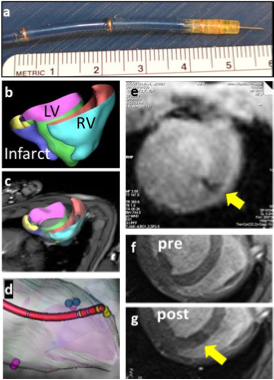Transmyocardial therapeutic-delivery using real-time MRI guidance
 Thursday, March 28, 2013 at 12:01PM
Thursday, March 28, 2013 at 12:01PM Entry, Abstracts
Jeremy Maurer, Penn
 Fig.1 (a) Needle catheter showing microcoils and extended nitinol injection needle. (b) Portions of the heart segmented on cine stack (TR/TE=3.4/1.54ms, voxel=1.3x1.3x5 mm3, FA 43o) are used to build 3d model of the left, right ventricle and infarcted region. (c) 3D model overlaid into real-time MR images is used to (d) navigate the catheter to pre- defined injection targets. Catheter model is built from MR images of active tracking coils. (e) Injection of iron-oxide laden therapeutic into myocardium (yellow arrow) monitored under real-time MRI. TR/TE=2.8/1.19 ms, voxel=1.9x1.9x5mm3, FA/tracking FA =50o/15o, 1.5-4 frames/s. (f, g) Pre- and post- injection MRI confirms injection of microbeads. TR /TE = 6.8/3.25ms, FA=30o, voxel =1.0×1.0×5.0mm3.Hegde S, Shea S, Pan L, Karmakar P, Barbot J, Kirchberg K, Vadakkumpadan F, Maurer J, Cook J, Trayanova N, Solaiyappan M, Johnston P, Kraitchman D. Transmyocardial Therapuetic-Delivery Using Real-Time MRI Guidance. SCMR 16th Annual Scientific Sessions, San Francisco, CA, January 31 - February 3, 2013. Poster.
Fig.1 (a) Needle catheter showing microcoils and extended nitinol injection needle. (b) Portions of the heart segmented on cine stack (TR/TE=3.4/1.54ms, voxel=1.3x1.3x5 mm3, FA 43o) are used to build 3d model of the left, right ventricle and infarcted region. (c) 3D model overlaid into real-time MR images is used to (d) navigate the catheter to pre- defined injection targets. Catheter model is built from MR images of active tracking coils. (e) Injection of iron-oxide laden therapeutic into myocardium (yellow arrow) monitored under real-time MRI. TR/TE=2.8/1.19 ms, voxel=1.9x1.9x5mm3, FA/tracking FA =50o/15o, 1.5-4 frames/s. (f, g) Pre- and post- injection MRI confirms injection of microbeads. TR /TE = 6.8/3.25ms, FA=30o, voxel =1.0×1.0×5.0mm3.Hegde S, Shea S, Pan L, Karmakar P, Barbot J, Kirchberg K, Vadakkumpadan F, Maurer J, Cook J, Trayanova N, Solaiyappan M, Johnston P, Kraitchman D. Transmyocardial Therapuetic-Delivery Using Real-Time MRI Guidance. SCMR 16th Annual Scientific Sessions, San Francisco, CA, January 31 - February 3, 2013. Poster.
Background: Catheter-based transmyocardial injection offers a minimally invasive method to deliver therapeutics to the heart. It is typically performed under X-ray fluoroscopic guidance, which suffers from poor demarcation of myocardial boundaries and an inability to assess myocardial viability. MRI-guided intramyocardial delivery of therapeutics at 3T offers the potential for more precise targeting of these therapies with superior tissue contrast.
Our group has been actively involved with microencapsulated stem cell therapy to improve cell retention and prevent stem cell rejection. However, most microencapsulated stem cell products are too large to be administered transmyocardially. We demonstrate here intramyocardial injection of a prototype single stem cell therapeutic into the myocardium of a normal swine using real-time MR guidance and a custom active injection catheter.
 Pennsylvania,
Pennsylvania,  abstract,
abstract,  cardiology,
cardiology,  imaging,
imaging,  research in
research in  Cases/Abstracts
Cases/Abstracts 